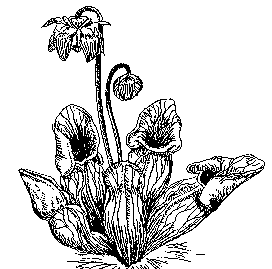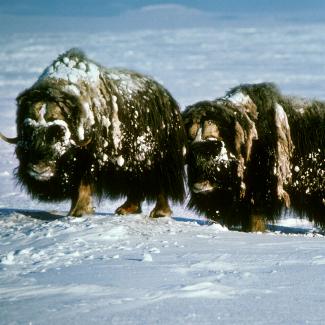Michigan's Meat-Eating Plants
 Carnivorous Plants Near You
Carnivorous Plants Near You
Like some kind of weird alien monsters out of science fiction, carnivorous plants are strange and even somewhat frightening. The most famous and popular of the insectivorous plants is the Venus flytrap (Dionaea muscipula). Although the Venus flytrap is not native to Michigan, it deserves some consideration as the most unearthly of the insect-eating plants. Its boggy home down in the Southeastern United States is similar to the swampy residence of our native Michigan insect eaters. The lack of soil nutrients is responsible for the need of the Venus flytrap to trap insects and digest their remains. The same is true of our Michigan carnivorous plants, like the pitcher plants, butterworts, and sundews. The mouth-like trap of the Venus flytrap attracts insects with its blushing red color and seductive scent. The unsuspecting bug crawls or lands on the open and ready trap, triggering the hairs that snap the trap shut. Even the reflexes of the fly are no match for the speed and power of the deadly leaves. Shortly after tightly closing on the squirming victim, the plant secretes its digestive enzymes and "eats" its hapless meal.
Although the Venus flytrap is the most active of the insectivorous plants, like any plant, it can do little more than sit there rooted to the ground. Also, they aren't very large, their traps are only about a half-inch across. So fantasy stories aside, there aren't wild vines that can drag you into their huge gapping flower-like mouth, devour you and spit your bones out after you have been digested.
The sundew plant is the next most active insect-eating plant compared to the Venus flytrap and it is just as strange. The round-leafed sundew (Drosera rotundifolia) is native to Michigan and although hard to find, it is locally abundant. Its trap is a small oval pad covered in small sticky hairs tipped with "dew". These pads are just about large enough to trap an ant attracted to the scent of the dew. Once the insect is stuck to the dewdrops and is struggling to get free, the hairs slowly turn inward as the pad curls around to cover its prey. A few days later the pad opens and becomes ready for its next snack.
The Michigan variety of the butterwort plant (Pinguicula) has a tongue-like leaf that curls up slightly at the edges in a gesture like it is lapping up bugs. Its leaves grow at a normally slow plant rate as they flatten out on the ground. The top surface of the butterwort leaf has two kinds of very small glands; there are stalked glands that are sticky and trap the insect and there are surface glands that produce digestive enzymes. Acting something like sticky flypaper, the butterwort leaves attract small flying insects like mosquitoes and gnats that get stuck and then digested.
Michigan's largest carnivorous plant, the Pitcher Plant (Sarracenia purpurea), is found in acidic bogs feeding on insects that are trapped in its pitcher-shaped leaves. Insects are attracted to the pitcher's red lip and crawl inside to eat the intoxicating nectar. Once inside they then fall into the bottom of the leaf. The leaves have downward-pointing hairs inside that keep insects from escaping. Insects that can't escape eventually drown in the water that collects in the bottom of the pitcher. Enzymes in the water digest the dead insects, providing the pitcher plants with nutrients. Although it is the largest carnivorous plant in Michigan, you might be able to fit your pinky finger in its trap if you have a small pinky.
Because these strange and wonderful plants exist in peat bogs, swamps, and wetlands, finding them growing in the wild requires lots of research and then ultimately hiking through unpleasant and sometimes dangerous areas. Finding the exact places won't be easy as these plants are often rare and endangered and so their whereabouts are a well-guarded secret. You'll need to know where and when to look for them. Once found in the wild it should be remembered that plants on public property are not to be removed or otherwise disturbed, however, fruits, nuts, and seeds often can be collected if the plants aren't somehow protected. These same species can often be purchased from licensed dealers such as nurseries. I recently bought a Venus flytrap that was grown commercially.
Given the variety of carnivorous plants and the advent of genetic modification, a new science fiction fantasy story about monster plants will certainly "crop up" soon. I imagine a ten-foot-tall pitcher plant with sundew-like tentacles, a Venus flytrap mouth, and butterwort tongue. Naturally, it will have the ability to roam about somehow, probably at an amazingly fast pace. Undoubtedly created by some disgruntled research scientist at a facility that produces genetically modified agricultural plants. Engineered to be resistant to herbicides, heat, drought, blight, and crop destroying pests it seems invincible when challenged by some he-man hero type. Eventually, some genetic engineering flaw is discovered that becomes the plant's Achilles' heel. Once the monster plant is defeated, we all learn a valuable lesson about messing with Mother Nature. Remember readers, you heard this story idea here first!
Comment about this article on the
Epress Forum Board
.
|
|
Michigan's Prehistoric Monsters
 Musk Ox survived the Ice Age Extinction
Musk Ox survived the Ice Age Extinction
We all know that the most popular prehistoric animals these days are the dinosaurs. The age of dinosaurs had many amazing species in every shape and size imaginable who occupied every niche in their environment. Dinosaurs swam, flew, ran, crawled, jumped, and did all the things living creatures do to survive and prosper. Due to some environmental cataclysm the dinosaurs went extinct and the age of mammals began. Having some traits that allowed them to survive, mammals diversified into various niches that became available as the environment stabilized and once again flourished. The mammals assumed every shape and size to occupy the niches left empty by the missing dinosaurs. Like the dinosaurs, the mammals progressed toward larger and more massive sizes until they reached an apex of enormous proportions. These huge prehistoric mammals are often referred to as "mega-fauna", the last of which died out a mere 10,000 years ago around the end of the Pleistocene Epoch (a period before, during, and at the end of the last ice age).
During the Pleistocene, humans lived alongside these gargantuan beasts and even depended on them for subsistence. Here, in Michigan, the glacier retreated around 12,000 years ago, about the same time the earliest people arrived. These first people, also known as "Proto-Indians", were the ancestors of the modern North American tribes. Except for these monstrous mammals, these Neolithic Natives of our state lived in a landscape, not unlike those in Northern Michigan today. Little is known of the daily lives of these people that lived at the end of the last Ice Age and archeologists are still uncovering new evidence that challenges their long held beliefs. Discoveries are beginning to paint a picture of these stone-aged people as smart, well-organized clans living Spartan lives in an inhospitable territory. Contrary to the popular image of the cavemen as primitive, brutish, and dumb as the rocks they used for spearheads, these "Proto-Indians" were far more advanced. It should be kept in mind that this was around the same time as the dawning of civilization when people were beginning to cultivate crops, domesticate animals and live together in permanent settlements. With so little evidence available and written historic accounts beginning only five centuries ago, the imagination can run wild in such a barbaric and unknown world.
We will never know everything about those days, but what we do know is what animals were here when the first people came and hunted them. Along with most of the same woodland species we have today, there were many additional animals that, although different, were like what we have today. The famous prehistoric Dire wolf would be hard to tell from a modern gray wolf that was also around at that time. There were animals that you wouldn't have expected to see here like camels, horses, and peccary. There was quite an exotic diversity of familiar animals mixed with the fantastic and unbelievable mega-fauna beasts. Truly the Great Lakes region was once an amazing and adventurous land to explore, as unbelievable as any lost world could be.
Here are some of the more famous mega-fauna animals that were here in Michigan in the Late Pleistocene Epoch starting with the largest and best known. The Jefferson's mammoth (Mammuthus jeffersoni) was a giant, wooly relative of the modern elephant. Some notable differences between elephants and mammoths are that the mammoth was hairier and larger than an elephant, it had tremendous tusks that curled upwards and its head had a domed shape top. Smaller than the mammoth, but still larger than an elephant, was the mastodon (Mammut americanum). Both of these hairy relatives of the elephant became extinct within a couple of thousand years after the first people arrived in the Great Lakes region around 12,000 years ago. Michigan never had cave bears, but we did have the giant short-faced bear (Actodus simus) that was about 30% larger than today's grizzly bear. Scott's moose was similar to modern moose but with longer legs and a different antler shape. The long-horned bison may have been in Michigan. It was slightly larger than the American bison and had long horns with a wide spread. Woodland Musk Oxen, similar to modern-day musk oxen further north, were in Michigan during those times. Let's not forget the improbable giant beaver that was about the size of today's black bears. A beaver that large could dam up a pretty big river and take down some sizable trees in the process! We didn't have the saber-toothed tiger or giant ground sloth, these were further to the south and west, but what could have matched the mighty mammoth?
As hard as their lives must have been, I still romanticize what it must have been like to live in that time. I imagine camping near receding glaciers in a tent made of mastodon skins and rib bones. I'm stretched out on bed of giant beaver pelts after a satisfying meal of mammoth meat. Everyone in the clan is proud of my skills with an atlatl (primitive spear-throwing device) that helped bring down the massive mammoth. My stories of the hunt and the perilous journey back to camp made the clan sing my praises around the cooking pits of the homecoming feast. A full stomach and the rhythmic beat of the celebration cause me to dose off as I wonder, "How it could get any better than this?".
Comment about this article on the
Epress Forum Board
.
|



